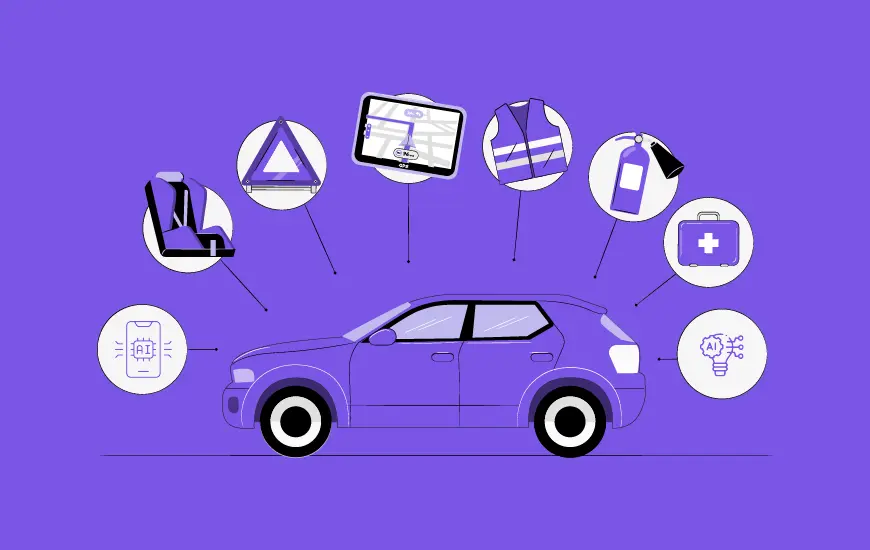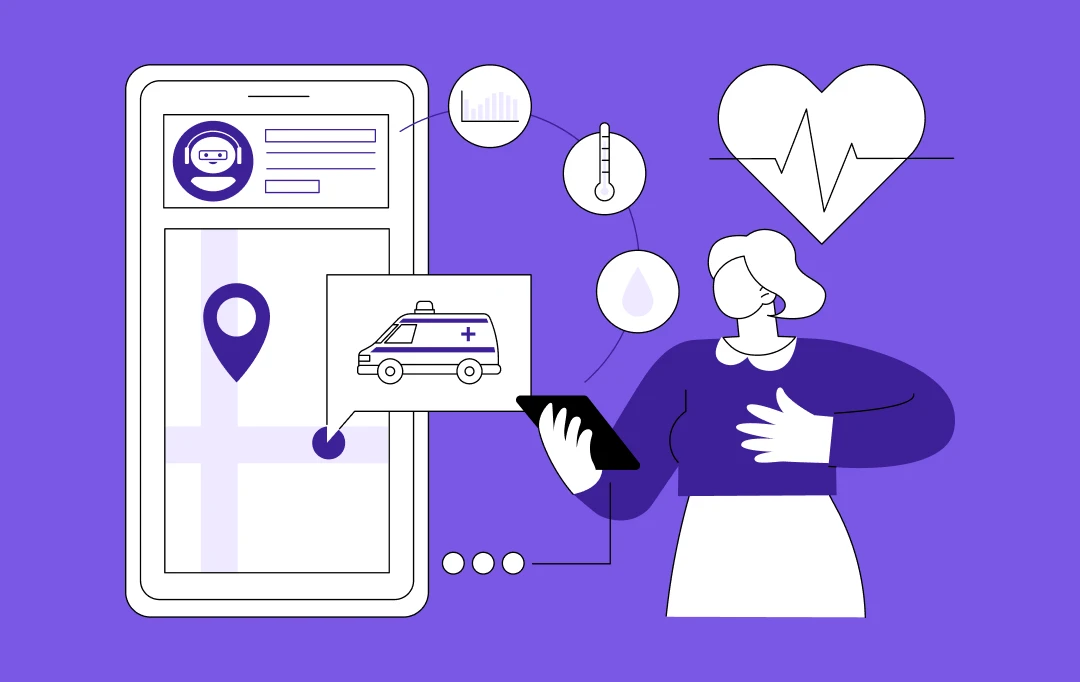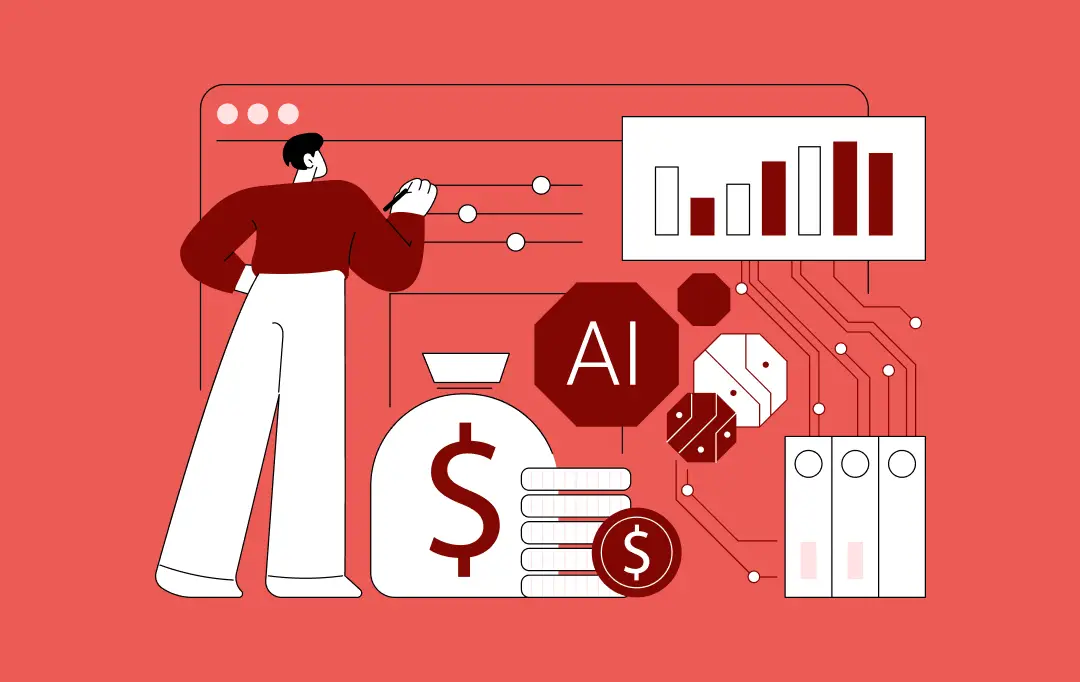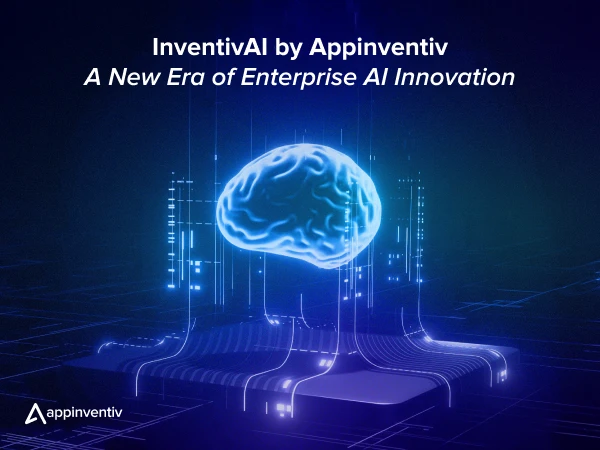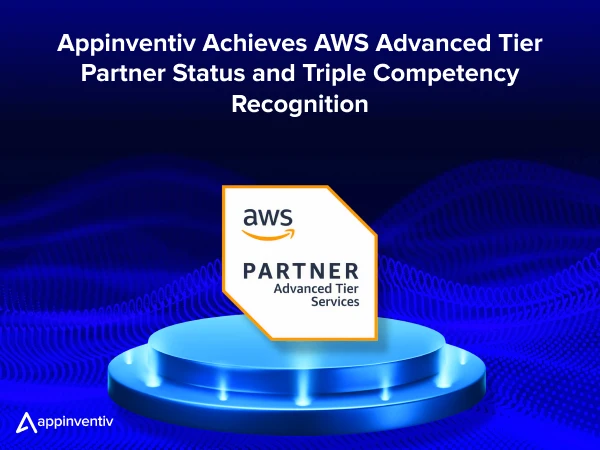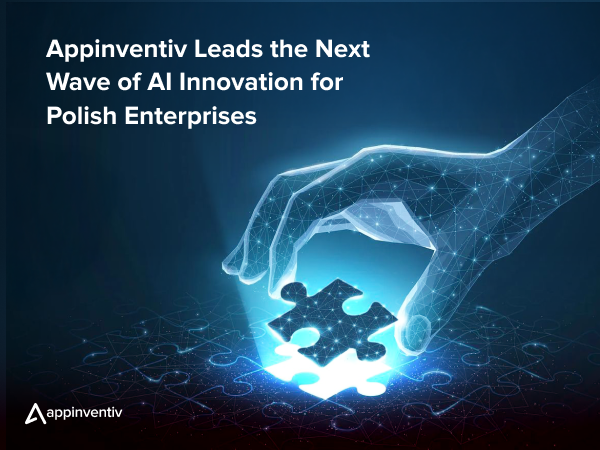- The Need for DevOps Automation
- Speed Without Sacrificing Stability
- Eliminating Human Errors and Improving Consistency
- Cost Optimization at Scale
- Strengthened Security and Compliance
- Enhancing Developer Productivity and Experience
- Breaking Silos with Cross-Team Collaboration
- Enabling Business Agility and Innovation
- Future-Proofing IT Operations
- What Parts of DevOps Can Be Automated?
- Continuous Integration & Continuous Deployment
- DevOps Automation Testing
- Application Performance Monitoring
- Network Provisioning
- Infrastructure as Code (IaC) & Configuration Management
- Log Management and Incident Response
- Provisioning & Environment Setup
- Automated Build Processes
- Release & Deployment Automation
- Monitoring & Operations Automation
- Governance & Compliance Enforcement
- Key Metrics for Successful DevOps Automation
- Deployment Frequency
- Deployment Speed (Lead Time for Changes)
- Change Failure Rate
- Mean Time to Recovery
- Defect Escape Rate
- Application Availability & Reliability
- The Process and Steps for DevOps Automation
- Identify the Current State of the DevOps Environment
- Highlight Areas that Need Automation
- Select the Right Tools
- Build the Automation Pipeline
- Test and Deploy the Automation Framework
- Monitor and Optimize the Automation Process
- What is the Cost for DevOps Automation?
- Best Practices for DevOps Automation
- 1. Automate What Matters, Not Just What’s Possible
- 2. Build for Failure
- 3. Embed CI/CD to Automate the Entire Development Lifecycle
- 4. Move Beyond Infrastructure-as-Code
- 5. Shift-Left Testing
- 6. Security and Compliance Shouldn’t Be Afterthoughts
- 7. Simplify Documentation
- Challenges in DevOps Automation
- 1. Complexity of Implementation
- 2. Security Risks in Automated Pipelines
- 3. Contaminated Code in the Pipeline
- 4. Loss of Human Awareness & Over-Reliance on Automation
- Appinventiv’s Role in DevOps Automation
- How We Automate DevOps for Maximum Efficiency
- Why Choose Appinventiv for DevOps Automation?
- FAQs
A product release delayed by weeks. A security patch stuck in approval cycles. A minor code change that breaks production. These challenges aren’t new, yet they remain all too common in enterprises trying to balance speed with stability.
The pressure to innovate faster while ensuring reliability has led many organizations to DevOps. But as businesses scale, even DevOps itself can become a bottleneck – manual workflows, fragmented toolchains, and inconsistent processes slowing teams down instead of empowering them. This is where DevOps automation changes the game.
By automating repetitive tasks, enforcing best practices, and streamlining deployments, organizations can move from reactive firefighting to proactive innovation. The result? Faster releases, fewer errors, and a resilient infrastructure that supports business growth instead of hindering it.

But what does automation in DevOps truly look like in action? How can enterprises adopt DevOps without disrupting existing workflows? And most importantly, how does it translate into tangible business outcomes? Let’s break it down.
This is your opportunity to break the manual cycle and embrace automation
The Need for DevOps Automation
As organizations scale, the demand for faster, more reliable software delivery grows. But traditional DevOps practices, while efficient, often struggle to keep pace with complex environments, evolving security threats, and increasing customer expectations. The benefits of DevOps automation aren’t just in optimization, it’s a necessity for businesses aiming to stay ahead. Here’s why:

Speed Without Sacrificing Stability
Automation in DevOps by implementing CI/CD pipelines, testing, and provisioning infrastructure eliminates bottlenecks that slow down releases. Software can move from development to production faster while maintaining high reliability.
Example: Netflix deploys code thousands of times per day across its microservices architecture. By leveraging automated DevOps pipeline and chaos engineering practices, they ensure seamless updates without service disruptions, keeping millions of users engaged.
Eliminating Human Errors and Improving Consistency
Manual configurations, deployments, and code integrations are prone to mistakes that lead to outages, security gaps, and performance issues. DevOps automation services standardize processes, reducing inconsistencies and ensuring each deployment follows the same high-quality standards.
Example: A leading financial institution suffered a multi-million-dollar loss due to a misconfigured database deployment. After adopting Infrastructure as Code (IaC) automation with Terraform, they eliminated configuration drift and prevented future misconfigurations.
Cost Optimization at Scale
Automated DevOps resource provisioning and intelligent workload scaling reduce unnecessary infrastructure costs. Instead of over-provisioning or running idle resources, businesses can ensure optimal utilization, lowering cloud expenses while improving efficiency.
Example: A hotel booking platform uses automated infrastructure scaling to handle traffic surges during peak booking seasons. By leveraging Kubernetes and auto-scaling groups, they optimize cloud resource usage, cutting infrastructure costs while ensuring uptime.
Strengthened Security and Compliance
Security threats evolve rapidly, and compliance requirements are becoming stricter. Automated security scans, policy enforcement, and threat detection ensure vulnerabilities are caught early, while compliance frameworks can be baked into the development process rather than addressed as an afterthought.
Example: A trading software integrates security automation into its DevOps pipeline, using tools like AWS Config and automated security scans to enforce compliance. This proactive approach helped them maintain regulatory standards while accelerating deployments.
Also Read: DevOps Compliance – The Answer to Enterprise Compliance-Readiness Roadblocks
Enhancing Developer Productivity and Experience
Developers spend a lot of time fixing misconfigurations, debugging deployment issues, or manually setting up environments. DevOps and automation removes these friction points, allowing them to focus on writing code and delivering new features instead of wrestling with infrastructure. DevOps outsourcing and automation eliminate these friction points, enabling them to focus on writing code and delivering new features instead of managing infrastructure.
Example: A coding tool internal DevOps automation tools allow developers to push code changes without worrying about underlying infrastructure, improving developer efficiency and accelerating feature rollouts.
Breaking Silos with Cross-Team Collaboration
DevOps infrastructure automation fosters a unified workflow between development, operations, and security teams. Automated workflows ensure everyone works within the same streamlined system, reducing miscommunication and speeding up issue resolution.
Example: A multinational retail company implemented GitOps practices with ArgoCD, enabling cross-functional teams to collaborate on infrastructure changes via a single version-controlled repository. This reduced deployment conflicts and increased operational efficiency.
Enabling Business Agility and Innovation
With DevOps workflow automation handling repetitive tasks, teams can shift their focus toward innovation-experimenting with new features, iterating quickly based on user feedback, and pivoting strategies when necessary. The ability to adapt swiftly gives businesses a competitive edge in dynamic markets.
DevOps Automation Example: A music streaming website uses automated feature flagging and canary releases to test new features on a subset of users before a full rollout. This allows them to experiment quickly, collect user feedback, and deploy changes with minimal risk.
Future-Proofing IT Operations
As organizations move towards AI-driven operations, automation forms the foundation. AI in DevOps plays a crucial role in enabling self-healing systems, predictive analytics, and autonomous workflows, all of which rely on businesses to automate DevOps as a stepping stone toward more intelligent, self-managing IT environments.
Example: A social media platform uses AI-driven automation in its data centers to predict hardware failures and proactively reroute traffic, ensuring minimal downtime and maximum efficiency.
DevOps automation solutions aren’t just about making processes faster – it’s about making them smarter. Businesses that prioritize automation not only gain efficiency but also build resilience, security, and flexibility into their core operations. The result? A streamlined IT landscape that supports growth, innovation, and long-term success.
What Parts of DevOps Can Be Automated?
DevOps automation goes beyond just speeding up software delivery – it minimizes human errors, ensures consistency, and allows teams to focus on innovation rather than repetitive tasks. From code integration to infrastructure management, nearly every stage of the DevOps lifecycle can benefit from automation, reducing bottlenecks and improving overall system resilience.

Continuous Integration & Continuous Deployment
Without automated DevOps, integrating code changes and deploying updates can become a slow and error-prone process. Automated CI/CD pipelines streamline this by running builds, executing tests, and pushing updates without manual intervention. Tools like Jenkins, GitHub Actions, and GitLab CI/CD ensure every code commit is tested and deployed efficiently, reducing the chances of failed releases and minimizing downtime.
DevOps Automation Testing
A single undetected bug can cause system failures or security vulnerabilities, making testing a crucial part of the development cycle. Manual testing, however, is slow and inconsistent. By applying a DevOps test automation strategy around the automation of unit, integration, functional, and security testing, teams can catch issues early and prevent defective code from reaching production. DevOps testing automation tools like Selenium, JUnit, and SonarQube integrate seamlessly into CI/CD pipelines, continuously validating code quality at every stage.
Application Performance Monitoring
Detecting and fixing performance issues before users are affected is a challenge when relying on manual monitoring. Automated APM solutions track system metrics, detect anomalies, and trigger alerts when performance deviates from expected thresholds. Platforms like New Relic, Datadog, and Prometheus provide real-time insights, ensuring applications remain stable under varying loads.
Network Provisioning
Configuring network resources manually can lead to inconsistencies and security risks. Automating network provisioning ensures firewalls, load balancers, and virtual networks are configured dynamically based on business needs. Cisco ACI, Terraform, and AWS CloudFormation allow teams to define network infrastructure as code, making deployments faster and more secure.
Infrastructure as Code (IaC) & Configuration Management
Traditional infrastructure management often leads to discrepancies between development and production environments. With IaC, cloud automation DevOps, infrastructure can be defined, versioned, and deployed automatically, ensuring consistency across environments. Ansible, Terraform, and Puppet help businesses automate the provisioning of servers, databases, and cloud resources, reducing deployment errors and speeding up scaling efforts.
Log Management and Incident Response
When systems generate thousands of logs per second, identifying critical issues manually is nearly impossible. Automated log management solutions centralize logs, analyze patterns, and trigger alerts for potential issues. Splunk, ELK Stack (Elasticsearch, Logstash, Kibana), and Datadog help teams detect security breaches, application errors, and performance bottlenecks before they escalate.
Provisioning & Environment Setup
Setting up development and testing environments manually is time-consuming and often leads to inconsistencies. Automation ensures environments are provisioned identically across teams, reducing conflicts between development, testing, and production stages. Docker and Kubernetes streamline this process by packaging applications with all dependencies, making deployments seamless across different platforms.
Automated Build Processes
Managing dependencies and building applications manually can result in version conflicts and unreliable software builds. Automated build systems compile code, resolve dependencies, and generate deployable artifacts in a controlled manner. Maven and Gradle handle these processes efficiently, ensuring reliable and repeatable builds.
Release & Deployment Automation
Releasing software updates manually is risky, often leading to downtime or failed deployments. DevOps automated deployment enables strategies like rolling deployments, blue-green deployments, and canary releases, minimizing service disruptions. Spinnaker and ArgoCD help teams implement zero-downtime deployments with automated rollback mechanisms, ensuring business continuity.
Monitoring & Operations Automation
Keeping systems operational requires continuous tracking of server health, database performance, and application availability. Automated monitoring solutions integrate with alerting systems to detect and resolve issues proactively. PagerDuty and Opsgenie notify on-call engineers about critical incidents, while self-healing mechanisms in platforms like Prometheus and Grafana automatically remediate common issues.
Governance & Compliance Enforcement
As organizations scale, enforcing security policies and regulatory compliance manually becomes impractical. Governance part of the automated DevOps pipeline helps ensure configurations adhere to industry standards, reducing security risks. Open Policy Agent and AWS Config enforce compliance by validating infrastructure and access policies automatically, ensuring businesses meet regulatory requirements without slowing down development.
Let us rebuild your infrastructure.
The process to automate DevOps isn’t just about improving efficiency, it also creates a more reliable, scalable, and secure software development process. By integrating the right tools across CI/CD, testing, infrastructure management, and monitoring, organizations can eliminate bottlenecks, enhance system resilience, and accelerate digital transformation.
The key lies in identifying repetitive tasks, implementing DevOps workflow automation gradually, and continuously optimizing processes to adapt to evolving business needs.
Key Metrics for Successful DevOps Automation
Success in DevOps isn’t just about introducing it in every process to speed up releases; it’s about maintaining stability, minimizing failures, and ensuring that automation drives meaningful business outcomes. This is where key performance indicators come into play. By tracking the right metrics, organizations can measure the impact of automation DevOps, identify bottlenecks, and continuously refine their DevOps build and test automation strategy.
From deployment frequency to system reliability, these metrics serve as a quantifiable benchmark for improvement, helping teams make data-driven decisions. In the following sections, we’ll explore the essential KPIs that define a successful automated DevOps pipeline strategy and how they shape high-performing engineering teams.

Deployment Frequency
The number of times new code is deployed to production over a given period. Higher deployment frequency indicates an efficient CI/CD pipeline with minimal bottlenecks.
Deployment Speed (Lead Time for Changes)
The time taken for a code change to move from development to production. Shorter lead times suggest streamlined automation in testing, approvals, and releases.
Change Failure Rate
The percentage of deployments that result in a failure requiring a rollback or hotfix. A lower CFR indicates better pre-deployment testing and higher release stability.
Mean Time to Recovery
The average time required to restore service after an incident or failure. Faster recovery times indicate effective monitoring, alerting, and automated remediation processes.
Defect Escape Rate
The percentage of defects that bypass automated testing and reach production. A lower defect escape rate reflects the effectiveness of test automation in catching issues early.
Application Availability & Reliability
Measures system uptime, error rates, and performance stability. Higher availability and fewer incidents signal a mature, automated DevOps process with strong infrastructure resilience.
By continuously monitoring these DevOps infrastructure automation metrics, teams can identify inefficiencies, fine-tune automation strategies, and improve overall software delivery. A well-automated DevOps workflow not only accelerates deployments but also enhances system stability and operational efficiency.
Also Read: The Potential of ChatGPT for DevOps in Streamlining Operations
The Process and Steps for DevOps Automation
A structured approach to DevOps automation ensures that organizations maximize efficiency while maintaining system stability and outperforming every KPI metric setup. As we have pressed down upon earlier as well, simply implementing tools isn’t enough – automation should be strategic, iterative, and aligned with business goals. Here’s a step-by-step breakdown of the process:
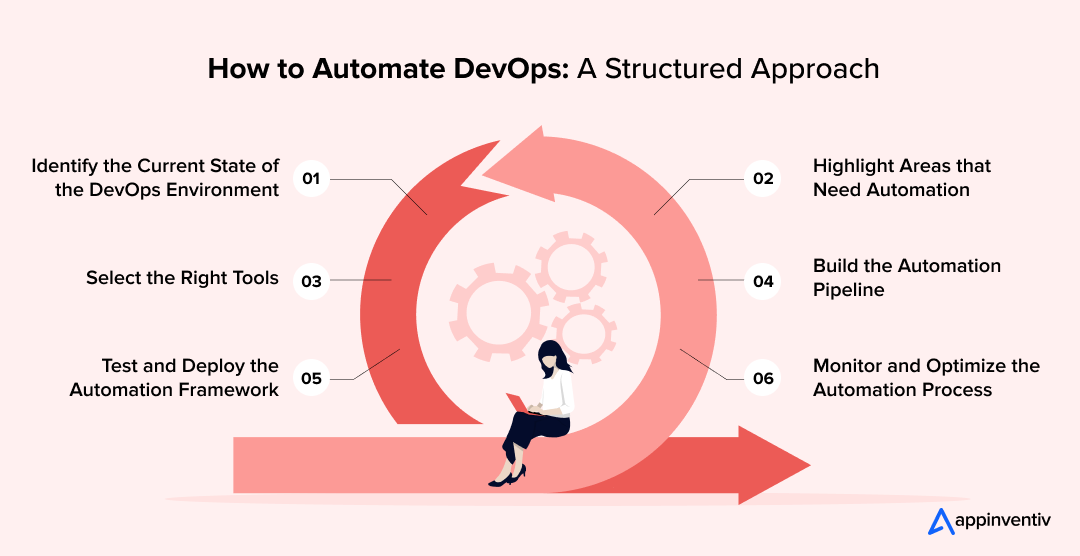
Identify the Current State of the DevOps Environment
Before automating anything, it’s essential to assess the existing DevOps landscape. This involves:
- Mapping out the current development, testing, deployment, and monitoring workflows.
- Identifying manual processes that slow down releases or introduce errors.
- Evaluating the performance of existing tools and infrastructure.
This initial assessment provides a baseline for measuring improvements post-automation.
Highlight Areas that Need Automation
Not every DevOps process should be automated immediately. Prioritization is key. Teams should:
- Identify high-impact, repetitive tasks that slow down deployments.
- Assess which manual processes introduce inconsistencies or bottlenecks.
- Focus on automation areas that align with business objectives, such as improving deployment speed or reducing downtime.
Common automation candidates include CI/CD pipelines, infrastructure provisioning, testing, monitoring, and security enforcement.
Select the Right Tools
Choosing the right tools for cloud automation DevOps, DevOps automated deployment, and DevOps testing automation depends on factors like team expertise, infrastructure compatibility, and scalability needs. Some widely used platforms include:
- CI/CD: Jenkins, GitHub Actions, GitLab CI/CD
- Infrastructure as Code: Terraform, Ansible, CloudFormation
- Testing Automation: Selenium, JUnit, SonarQube
- Monitoring & Logging: Prometheus, Datadog, ELK Stack
- Security & Compliance: HashiCorp Vault, Open Policy Agent
A toolchain that integrates seamlessly across development, operations, and security functions ensures a smooth automation transition.
Build the Automation Pipeline
With the right tools in place, teams need to design a DevOps workflow automation pipeline that:
- Automates code integration, testing, and deployment with minimal manual intervention.
- Ensures infrastructure is provisioned and configured automatically to match application needs.
- Establishes security and compliance checks at every stage to mitigate risks.
At this stage, collaboration across Dev, Ops, and Security teams is crucial to align automation with operational workflows.
Test and Deploy the Automation Framework
Before rolling out DevOps automation services across production systems, rigorous testing is required. This includes:
- Running sandbox tests to ensure the automation framework works as expected.
- Simulating real-world scenarios to detect failures and validate system resilience.
- Deploying automation in phases to minimize disruption and catch issues early.
Continuous testing of automation in DevOps ensures that automation enhances efficiency rather than introducing new risks.
Monitor and Optimize the Automation Process
Automation in DevOps is not a one-time setup – it requires continuous monitoring and refinement. Organizations should:
- Track key DevOps metrics such as deployment speed, failure rates, and system uptime.
- Use real-time monitoring tools to detect anomalies and trigger alerts when needed.
- Iterate on automation pipelines based on feedback and performance data.
By consistently fine-tuning automation strategies, organizations can ensure long-term scalability, reliability, and operational excellence.
Automation in DevOps is an ongoing journey, not a one-off implementation. As technologies evolve and business needs shift, automation processes must adapt accordingly. By following a structured approach, starting with assessment, tool selection, and phased deployment, organizations can drive meaningful DevOps and automation transformation and gain a competitive edge in software delivery.
Also Read: 7 Successful Steps to DevOps Adoption and Implementation
Let us handle it for you while you take care of your business.
What is the Cost for DevOps Automation?
The cost for DevOps automation varies based on company size, infrastructure complexity, and tool selection. For small to mid-sized organizations, initial investments in automation tools, cloud resources, and skilled professionals can range between $40,000 to $200,000. Larger enterprises with complex architectures may spend $500,000 or more on full-scale automation, including CI/CD pipelines, security integration, and infrastructure provisioning.
While the upfront costs may seem high, the benefits of DevOps automation can be seen in it reducing long-term operational expenses by up to 30-50%, thanks to improved efficiency, reduced failures, and faster deployments.
Best Practices for DevOps Automation
Automating DevOps is a strategic automation that enhances efficiency while keeping flexibility intact. The following best practices ensure that your automation DevOps journey is scalable, secure, and sustainable.

1. Automate What Matters, Not Just What’s Possible
While automation eliminates repetitive work, not everything should be automated. Over-automation can introduce rigid workflows and unnecessary complexity.
- Prioritize bottlenecks in CI/CD, testing, security enforcement, and cloud provisioning.
- Use low-code or no-code automation for simple workflows, but keep human control for critical decision-making.
- Continuously evaluate automation ROI – if it’s not saving time or reducing errors, rethink its value.
2. Build for Failure
Automation makes processes faster, but it also accelerates failures if something goes wrong. A resilient system should be built with proactive failure handling.
- Self-healing pipelines: Auto-restart failed deployments and roll back to stable versions.
- Chaos engineering: Simulate failures in a controlled way using tools like Gremlin or Chaos Monkey to test resilience.
- Automated root cause analysis: Tools like Dynatrace and New Relic help pinpoint failure sources instantly.
3. Embed CI/CD to Automate the Entire Development Lifecycle
A well-structured CI/CD pipeline is the backbone of DevOps infrastructure automation. Without it, automation remains fragmented and ineffective.
- Use declarative pipelines in tools like Jenkins, GitHub Actions, or GitLab CI/CD to maintain consistency.
- Automate progressive rollouts (e.g., blue-green deployments and canary releases) to minimize disruption.
- Integrate compliance-as-code to enforce security policies during builds.
4. Move Beyond Infrastructure-as-Code
Infrastructure as Code tools like Terraform and AWS CloudFormation are widely used, but they only address provisioning, not governance.
- Combine IaC with policy-based automation tools like Open Policy Agent to enforce security and compliance at runtime.
- Implement auto-scaling triggers based on real-time workload monitoring to optimize cloud costs.
- Automate resource cleanup to eliminate unused cloud instances and reduce unnecessary spending.
5. Shift-Left Testing
The earlier bugs are caught, the cheaper they are to fix. Shift-left testing part of the DevOps and automation process ensures quality is built into development, rather than being checked later.
- Automate unit, integration, and regression testing within CI/CD pipelines.
- Use AI-driven testing platforms like Testim and Mabl for predictive test automation.
- Implement security testing (SAST & DAST) during code commits, rather than post-deployment.
6. Security and Compliance Shouldn’t Be Afterthoughts
Many DevOps pipelines lack built-in security automation, making systems vulnerable to breaches and compliance failures.
- Automate secrets management with tools like HashiCorp Vault and AWS Secrets Manager.
- Use container security tools like Aqua Security or Prisma Cloud to scan for vulnerabilities in Docker and Kubernetes.
- Enforce role-based access control and zero-trust models in automated scripts.
7. Simplify Documentation
With automation in DevOps handling most processes, teams must understand how systems work without excessive documentation.
- Maintain self-documenting scripts with clear, inline comments.
- Use automated documentation tools like MkDocs or Confluence integrations to generate and update records dynamically.
- Keep documentation actionable and concise, long guides often go unread.
DevOps automation isn’t just about speeding up processes; it’s about building reliable, resilient, and secure systems. By following these best practices, organizations can achieve high-velocity software delivery without compromising security or stability.
Challenges in DevOps Automation
Even after following the best practices and approaches for automation DevOps, there is a probability that you will encounter a set of challenges. In our journey as DevOps services providers, we too have come across and solved a number of automation issues to ensure seamless adoption and long-term success. Here’s a breakdown of those.
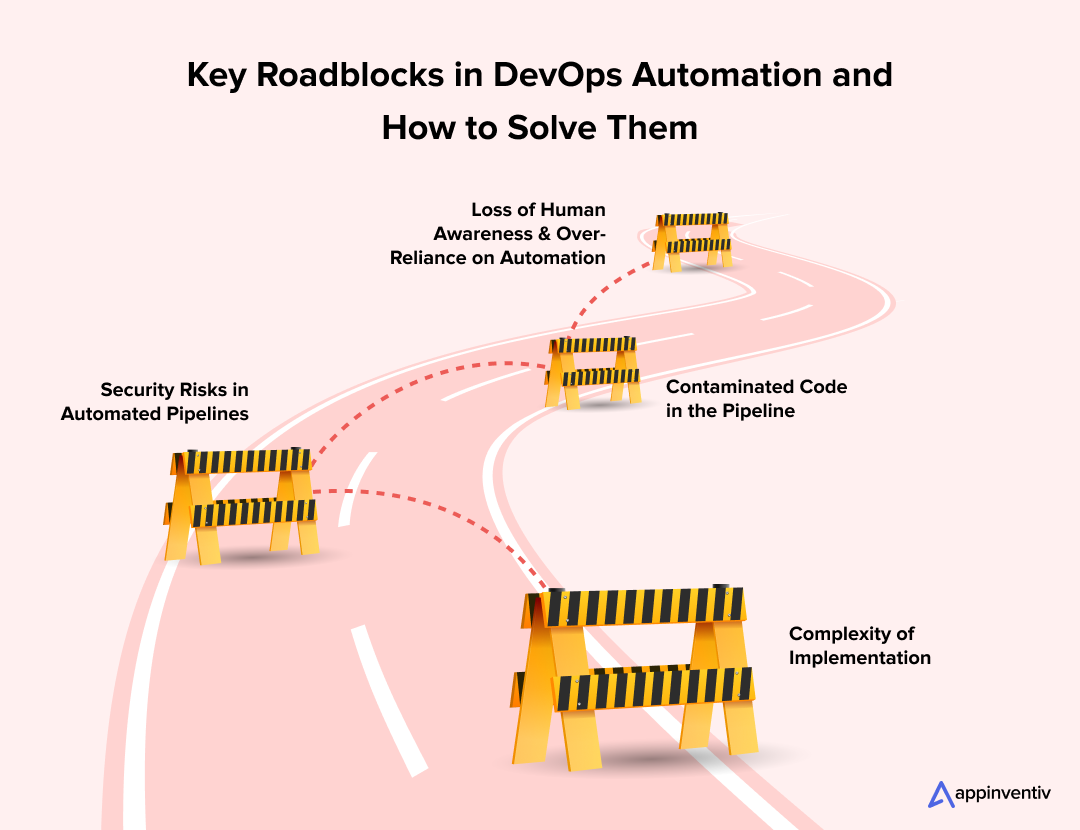
1. Complexity of Implementation
DevOps automation solutions are not a plug-and-play process – it requires careful integration of tools, workflows, and security policies.
- Toolchain compatibility issues, especially in multi-cloud or hybrid environments.
- Managing dependencies between automated tasks and existing manual processes.
- Training teams to adopt and manage automated pipelines effectively.
A phased automation approach, coupled with comprehensive documentation and team training, helps reduce complexity.
2. Security Risks in Automated Pipelines
Automation in DevOps increases speed and consistency, but it can also amplify vulnerabilities if security isn’t embedded into the process. Common risks include:
- Unsecured credentials being exposed in code repositories.
- Automated deployment errors leading to security misconfigurations.
- Lack of governance in Infrastructure as Code, increasing compliance risks.
Implement DevSecOps principles, enforce role-based access controls, and use automated security scanning at every stage of the pipeline.
3. Contaminated Code in the Pipeline
When code moves through an automated pipeline at high velocity, defective or malicious code can slip into production if quality checks are inadequate. Issues include:
- Insufficient automated testing, leading to undetected defects.
- Pipeline failures when dependencies aren’t properly validated.
- Human oversight reduction, causing potential blind spots in the automation process.
Strengthen DevOps automation testing coverage, enforce code review policies, and use AI-driven anomaly detection to spot irregularities.
4. Loss of Human Awareness & Over-Reliance on Automation
Over-automation can lead to a false sense of security, where teams blindly trust automated processes without manual verification. Risks include:
- Reduced situational awareness during incidents.
- Automated scripts failing silently, leading to undetected production failures.
- Lack of manual intervention strategies, making troubleshooting more difficult.
Maintain human oversight in critical processes, implement manual approval gates for sensitive deployments, and use AIOps for proactive monitoring rather than reactive responses.
While these challenges are significant, strategic planning, continuous monitoring, and security-first DevOps automation consulting and execution practices can help organizations mitigate risks and optimize their DevOps automation journey.
Appinventiv’s Role in DevOps Automation
At Appinventiv, we provide end-to-end DevOps services that help businesses accelerate deployments, optimize cloud resources, and minimize operational costs. Whether you’re a startup looking to scale rapidly or an enterprise aiming for efficiency, our automation-first approach eliminates bottlenecks, reduces manual effort, and ensures a seamless development lifecycle.
How We Automate DevOps for Maximum Efficiency
- Infrastructure Provisioning & Environment Setup
Setting up and managing infrastructure manually is time-consuming and prone to errors. We automate the entire process using Infrastructure as Code tools like Terraform, AWS CloudFormation, and Pulumi, ensuring:
- Faster environment setup, saving 40-60 hours per month in manual configurations.
- Consistent infrastructure across dev, staging, and production with version-controlled deployments.
- Stronger security and compliance enforcement through automated policy checks.
- CI/CD Pipeline Automation for Faster Deployments
A fully automated CI/CD pipeline eliminates delays in software delivery, ensuring rapid and reliable releases. Our expertise includes:
- Pipeline automation with Jenkins, GitHub Actions, GitLab CI/CD, and ArgoCD for seamless deployments.
- Automated rollback mechanisms to prevent downtime in case of deployment failures.
- Up to 80% reduction in deployment time, boosting development velocity.
- Auto-Scaling & Cloud Resource Optimization
We help businesses cut unnecessary cloud expenses with automated resource scaling and intelligent workload management. Our approach includes:
- Horizontal and vertical auto-scaling using Kubernetes, AWS Auto Scaling, and GCP Autoscaler.
- Dynamic load balancing to ensure high availability and optimal performance.
- Eliminating over-provisioning costs, reducing cloud expenses by up to 50%.
- Automated Database Management & Backups
Manual database management increases operational overhead and security risks. Our automation in DevOps-first approach ensures:
- Seamless database provisioning and configuration using tools like Flyway and Liquibase.
- Automated backups and disaster recovery, minimizing the risk of data loss.
- Performance tuning through AI-driven optimizations, reducing the need for a full-time database administrator.
Why Choose Appinventiv for DevOps Automation?
By partnering with us, you will get
- Up to 60% reduction in DevOps costs – eliminating the need for a full in-house DevOps team.
- Faster time-to-market – allowing you to focus on product innovation instead of infrastructure management.
- Higher system reliability and uptime – with automated monitoring, logging, and alerting solutions.
Ready to transform your DevOps processes? Let’s automate your infrastructure, CI/CD, security, and more, so you can focus on scaling your business. Talk to our DevOps experts today.
FAQs
Q. What is DevOps automation?
A. DevOps automation refers to the process of using tools, scripts, and workflows to automate repetitive DevOps tasks, such as code integration, testing, deployment, infrastructure provisioning, and monitoring. By eliminating manual interventions, businesses can accelerate software releases, improve reliability, and reduce operational overhead.
Q. How does DevOps automation of testing reduce holding costs?
A. Holding costs in software development refer to the expenses incurred due to delays in releasing new features or bug fixes. DevOps automation in testing helps reduce these costs by:
- Accelerating test cycles – automated tests run faster and more frequently than manual ones.
- Detecting defects earlier – reducing the risk of costly post-deployment fixes.
- Minimizing the need for manual testers, leading to lower resource costs.
By integrating automated testing into CI/CD pipelines, businesses can ensure faster time-to-market and lower holding costs.
Q. How much does it cost to implement DevOps automation?
A. The cost of DevOps automation varies based on factors such as company size, infrastructure complexity, and tool selection. On average, businesses can expect:
- $40,000 to $200,000 for small and mid-sized businesses implementing DevOps automation from scratch.
- $200,000 to $500,000+ for enterprises requiring advanced automation, multi-cloud integrations, and security compliance.
Costs also depend on tool licensing, cloud expenses, consulting fees, and ongoing maintenance. However, automation reduces long-term operational costs by up to 60%, making it a high-ROI investment.
Q. What is the difference between QA automation and DevOps automation?
A. QA Automation focuses on automating software testing (unit tests, functional tests, regression tests) to ensure quality before deployment. It helps catch bugs early and improve software reliability.
DevOps Automation encompasses a broader range of automation tasks, including CI/CD, infrastructure provisioning, configuration management, monitoring, and security compliance.
In short, QA automation is a subset of DevOps automation, primarily targeting testing, while DevOps automation covers the entire software development and deployment lifecycle.


- In just 2 mins you will get a response
- Your idea is 100% protected by our Non Disclosure Agreement.

How to Choose the Right DevOps Automation Tools for Your Business?
Key takeaways: Picking the right DevOps automation tools can turn release chaos into control. Smart automation enhances speed, reliability, and team efficiency. Tool selection should align with business goals, not market hype. Over-automation and poor alignment often lead to project failure. A well-planned DevOps setup drives measurable and sustainable business growth. Let’s be honest -…

Transforming Private ROSA Deployments with Automated Tekton CI/CD
In today’s cloud-native world, application teams seek automation, security, and scalability without trade-offs. Red Hat OpenShift Service on AWS (ROSA) delivers a managed Kubernetes experience with enterprise-grade features. But when clusters run in private subnets for security, it creates a common challenge: how do you enable CI/CD pipelines that rely on external triggers, like GitHub…

DevOps Maturity: Why It Matters and How Business Leaders Can Achieve It
Key takeaways: Business Impact: High DevOps maturity correlates with 1.5x higher revenue growth and significantly lower operating costs. The Reality Gap: While many adopt "tools," few achieve true maturity—struggling with silos and fragmented pipelines. The Roadmap: Maturity is a 5-stage journey from ad-hoc firefighting to AI-driven self-healing systems. Actionable Steps: Success requires measuring DORA metrics,…








